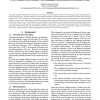Free Online Productivity Tools
i2Speak
i2Symbol
i2OCR
iTex2Img
iWeb2Print
iWeb2Shot
i2Type
iPdf2Split
iPdf2Merge
i2Bopomofo
i2Arabic
i2Style
i2Image
i2PDF
iLatex2Rtf
Sci2ools
LREC
2008
2008
Elicited Imitation as an Oral Proficiency Measure with ASR Scoring
This paper discusses development and evaluation of a practical, valid and reliable instrument for evaluating the spoken language abilities of second-language (L2) learners of English. First we sketch the theory and history behind elicited imitation (EI) tests and the renewed interest in them. Then we present how we developed a new test based on various language resources, and administered it to a few hundred students of varying levels. The students were also scored using standard evaluation techniques, and the EI results were compared to more traditionally derived scores. We also sketch how we developed a new integrated tool that allows the session recordings of the EI data to be analyzed with a widely used automatic speech recognition (ASR) engine. We discuss the promising results of the ASR engine's processing of these files and how they correlated with human scoring of the same items. We indicate how the integrated tool will be used in the future. Further development plans and...
| Added | 29 Oct 2010 |
| Updated | 29 Oct 2010 |
| Type | Conference |
| Year | 2008 |
| Where | LREC |
| Authors | C. Ray Graham, Deryle Lonsdale, Casey Kennington, Aaron Johnson, Jeremiah McGhee |
Comments (0)

